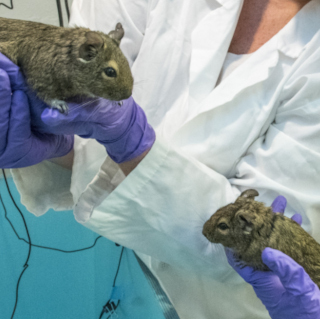Staphylococcus aureus or Other BSL-2 Infectious Bacteria
Last Review Date: December 15, 2020
Background Information
All work will be conducted at BSL2 in a Type II Biosafety Cabinet (BSC). Mice or rats may be used for these studies. On the day of inoculation, cultures of S. aureus or other BSL-2 infectious bacteria will be prepared in a BSC in the laboratory of the PI and placed into individual doses in syringes, packaged per Institutional Biosafety Committee (IBC) requirements for transport to the animal facility where the inoculae is placed into the animal BSC in the ABSL-2 room in LAR.
Animals will be inoculated following the AUP protocol. All syringes will be disposed of appropriately into biohazard sharps containers.
Thoroughly wash hands with soap and water before leaving the laboratory and after handling infectious materials.
Signage
Appropriate biohazard signage will be posted in the laboratory and in the ABSL-2 room in the animal facility to prevent unauthorized entry to the restricted area during bacteria preparation, inoculation, and harvesting. Cages with inoculated mice will be appropriately labeled as containing S. aureus or the bacteria in use.
PPE
All personnel working with S. aureus or other infectious bacteria or infected animals must wear:
- Disposable surgical mask
- Disposable gloves
- Lab coat with elasticized fitting at the wrists
All work with infectious bacteria or infected animals and their caging, bedding, etc. will be conducted in a BSC in a designated ABSL-2 room.
Non-disposable materials coming into contact with an
Disease Condition in the Animals
Transmission of infection can occur through contact with infected animals or their secretions. All bedding and cage material and equipment should be considered to carry infectious organisms. Potentially, viable bacteria may be excreted in the urine if sufficient kidney damage occurs. The rate of excretion is unknown and varies depending on the
S. aureus is susceptible to common disinfectants used in animal facilities and to mechanical or chemical sterilization. All bedding, unused food, and water, disposable gloves, paper towels used for wiping surfaces will be steam-sterilized in red biohazard bags. All racks for housing animals will be disinfected using Peroxigard and then washed in the cage washer.
Waste Disposal
All dirty bedding and carcasses will be handled as biohazards and autoclaved before routine cleaning or disposal, respectively. All bedding, unused food,
Clean Up
All spills of live cultures should be treated with 10% bleach or Peroxigard prior to cleaning up with paper towels. Paper towels should then be collected into biohazard bags and sealed for further steam sterilization.
Thoroughly wash hands after handling infectious materials.